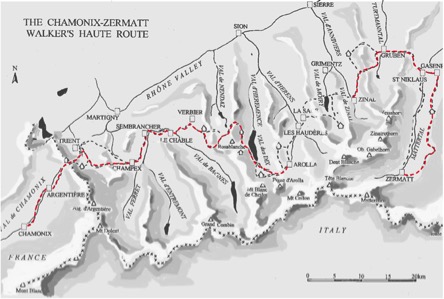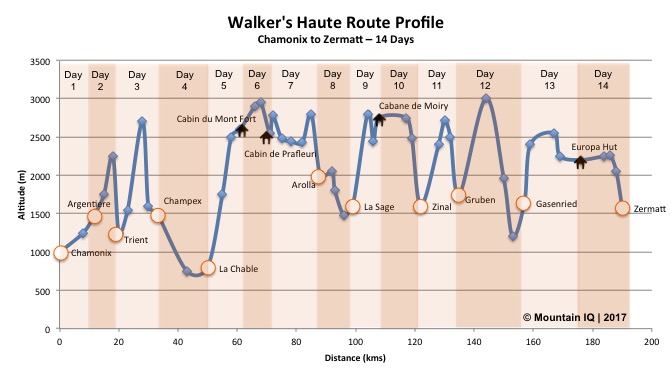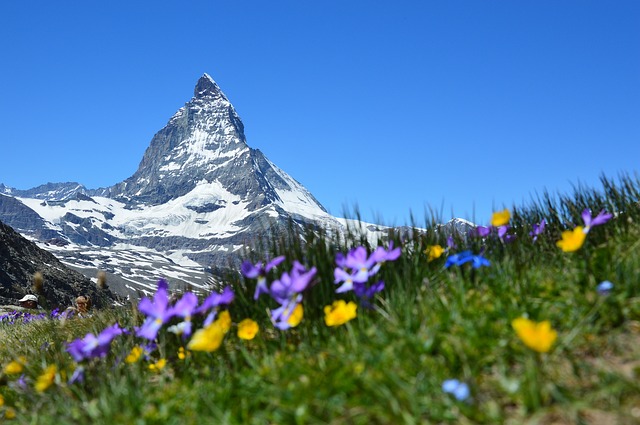The Walker's Haute Route is a 14 day trek from Chamonix to Zermatt, or in different words from the base of the Mont Blanc to the Matterhorn, one of the most iconic mountains in the world.
It is located in a place where France, Switzerland and Italy meet: the Alps.
The Haute route started as a mountaineering trail connecting two great mountaineering centres. The Walker's Haute Route is the ‘lower’ variant of this trail aiming at hikers wishing to spend two weeks overshadowed by the highest mountains in Western Europe.
Walkers Haute Hike
The Walker's Haute Route is one of Europe's best hikes, but also one of its most demanding. The route has a total distance of 180-200 kilometers depending on the stages you choose.
It starts off at the base of the Mont Blanc in Chamonix and ends in Zermatt, with views of the iconic Matterhorn.
The first three stages use the same trail as the famous Tour du Mont Blanc while the last few stages are similar to the Tour of the Matterhorn.
Along the way you’ll witness the greatest mountain views, spectacular valleys, delightful villages and remote alp hamlets.
The route crosses eleven passes, gains more than 12,000 meters and loses more than 10,000m.
Along the way you will spend some days in valleys, while other nights will be spent in mountain huts. In contrary to the Tour de Mont Blanc, the Walker's Haute Route is less walked and thus less-crowded.
Keen to hike the Tour du Mont Blanc? Check itineraries with our recommended tour operators: 4-Day Highlights Trip and 10-Day Full Tour.
What we like and dislike about this hike
Chamonix to Zermatt Route Map
This map illustrates the Walker's Haute Route.
It starts off at Chamonix, France close to the Swiss border before heading east towards the Mattertal. There are 12 or 14 stages depending on if you end your hike via the Europaweg or the traditional valley walk.
The Walkers Haute Route is a linear route.

Walkers Haute Hike Altitude Profile
In the chart below you can see the altitude profile of the full walk. It is quite clear there is a lot of altitude to be gained and distance to be covered over the 14 stages. You can see that there are a few strenuous stages ending at mountain huts that will require great effort.

Walker's Haute Itinerary
Below we have laid out the most popular version of the Walker's Haute Route – 14 days, leaving from Chamonix and finishing in Zermatt. The itinerary includes approx. distances, hiking times and elevation changes.
Day 1: Chamonix – Argentière
Day 2: Argentière - Trient
Day 3: Trient - Champex
Day 4: Champex – Le Chable
Day 5: Le Chable – Cabane de Mont Fort
Day 6: Cabane de Mont Fort – Cabane de Prafleuri
Day 7: Cabane de Prafleuri - Arolla
Day 8: Arolla – La Sage
Day 9: La Sage – Cabane de Moiry
Day 10: Cabane de Moiry - Zinal
Day 11: Zinal - Gruben
Day 12: Gruben - St Niklaus
Day 13: St Niklaus - Europahut
Day 14: Europahut - Zermatt
Route Variations (Chamonix to Zermatt)
Some stages of the Walker's Haute Route have alternative trails in case of bad weather. Here is the list of alternative for each of the stages:
- Alternative stage 3: Trient – Alp Bovine – Champex: Bad weather alternative through the forests and alpine meadows
- Alternative stage 6: Cabane de Mont Fort – Col de la Chaux – Cabane de Prafleuri: Little shorter than the traditional trail, but still demanding
- Alternative stage 7: Cabane de Prafleuri – Pas de Chevres – Arolla: This alternative stage passes along Cabane de Dix and the famous ladders of Pas de Chevres. Recommended!
- Alternative stage 11: Zinal – Hotel Weisshorn / Cabane Bella Tolla: Longer route than the traditional one. Mostly done when Hotel Weisshorn is the place you wish to spend the night.
- Alternative stage 11a: Hotel Weisshorn – Gruben: Extra stage to finish your hike to Gruben
- Alternative stage 13: St Niklaus – Zermatt: Traditional valley walk as alternative to the 2-day Europaweg. It is often regarded as an anticlimax regarding views and therefore hikers opt to do the Europaweg instead.
Video Overview of Walkers Haute Hike
A beautiful video overview of the Walker's Haute Route by Cicerone Press.
Frequently Asked Questions
How much does the Walker's Haute trek cost?
Are permits required for the Haute Route trek?
When is the best time to trek the Haute Route?
Is altitude sickness a risk?
How difficult is the Walker's Haute trek?
What gear do I need?
What travel insurance do I need?
Browse more hikes in Europe
See our top European hikes picks, or check out these popular hikes.


Hi,
We are planning to do the trail in 10 days, starting in Chamonix (and leaving our car there). Only we were wondering how we return back to Chamonix after arriving in Zermatt.
Kind regards
Lise
Hi Lise, the easiest is to take a train back to Chamonix. You can book tickets here: https://www.sbb.ch/en/home.html
It's really a package of information. I am planning to hike this route on summer. I wish to find some like minded people to join this trip with me.
Let me know when you would be up to it…I am also looking for a buddy to hike with… July/August 2023.
Hi Iva, if you’re looking for some hiking partners, I recommend checking out some of the open group trips on Skyhook, like this one: https://www.skyhookadventure.com/trips/tour-du-mont-blanc-highlights
I live in Colorado and am a climber, avid hiker / backpacker. I am wanting to do this solo next year and want to start planning. I have the guidebook but I honestly have no idea where to even start!!!! I am comfortable hiking 8 – 16 miles a day with plenty of elevation gain and gear. I would be open to tent camp and stay in huts. Any advice on where to start?
Hi Carissa, it is possible to hike the Walkers Haute route solo or self-guided. The trails are well marked and the hut accommodation good, unless of course you want to camp. In terms of hut accommodation you need to book early as they do get busy in the Summer. If you are going to solo the hike then I highly recommend this guidebook, it covers everything one needs to know. All the best!
Mountain IQ. Interested in 14 day Haute Route and Mont Blanc summit. Would love an itinerary and a quote.
Hi Karen, thanks for your comment. Unfortunately, we don’t arrange tours but feel free to get a quote from our recommended partner, here.
Could you advise about baggage transfer as my wife and I would like to walk most of the Haute Route but have limited time and do not want to carry a heavy load each day. For example the starting off stages would be Argentiere to Triente. Triente to Champex and Champex to Le Chable as listed (above). Do any companies arrange on a day to day basis if we include a rest day here and there or do we have to stay on a rigid timetable such as that we used on the West Highland Way?
Hi Kenneth, it really depends on each companies policy, some are quite flexible with self-guide treks, but I would reach out to a few and see if they can put together a bespoke plan for you.
Hi,
My friend and I are planning to take this hike from June 10 to June 23, 2019. We have 14 days, but we are worried about the time of the year.
Since this period will be late spring/beginning of summer, is it advisable to take this hike in June?
And many thanks for such detailed information.
Best regards,
Shanmu
Hi Shanmu, June can be a little dangerous in terms of snow cover and potential avalanche risk. That being said it is very much dependent on the previous season’s winter snow cover. If you can push you dates a few weeks forward then you should be guaranteed great conditions, but if you are restricted to mid June I would say go for it but be prepared to change your plans / have a Plan B if the conditions aren’t great.
Hi,
The information above is very useful. Do you have any recommendations on where to stay along this route?
Also – when booking huts – for example in Trient – should I be looking for huts in Trient Village or in the mountains?
Thanks,
Patrick
My husband and I are interested in combining the Tour du Mont Blanc and Walker’s Haute Route into a 25ish day hike- this would start in Chamonix, loop back to Chamonix on the TMB and then head up on the WHR to Zermatt. We have experience on three-week hikes with a lot of altitude gain/loss in the USA, but not in Europe. We are hoping to take tents and camp in where we are able. In your opinion does this sound like a good idea, or a little too over-enthusiatic?
Hi Stephanie, this sounds doable. You may need to skip a few stages (weather dependent), but I think over a 25 day period you can fit in combination hike of the two routes.
Amazing post man, there’s so much good info in there. Myself and a few friends are planning to do 2 nights and 3 days along the route starting at Le Chable and ending at Arolla. Is this possible to do? We’d leave the car in Le Chable and then get public transport back again. The other thing I’m wondering is whether or not the huts will be open. We’re doing it from the 14 – 18th September. I’ve emailed them but still waiting on a response.
These stages are well doable in three days. Both Le Chable and Arolla have good public transport options, so the itinerary should work.
About the huts: most huts in the Alps close around mid-september. There are no exact dates on their website but you can call them.
http://www.cabanemontfort.ch/hebergement.html
http://www.refuges-montagne.info/fr/cabane-prafleuri.php
Wow!! What an amazing, full of details article!! The video is beautiful, and gives a good idea of what to expect. I would love to walk this trail but I don’t think I am ready to walk on my own some of the parts… Could you recommend some organised groups for this trail?
Hi Natalie, joining an organised group is possible and recommended if you are trekking solo. There are many tour companies who offer the Walkers Haute route as a group adventure. I recommend Googling it.
Hi! We are planning a multi-day run on the Walker’s Haute Route- hoping to complete it in 6-7 days. Do you have recommendations for stages to combine? We are comfortable doing up to 35k in a day, and are thinking about starting in Argentiere because we’ve spent a good amount of time in the area between there and Chamonix. Thanks!
Running the whole trail is quite a challenge but if you’re well experienced, a real adventure. I have no experience in mountain running, but I think the terrain on some stages might make it difficult of making a lot of progress. Stage 6 and 7 have some boulder fields as these stages stay on high altitude. Also the Europaweg is very unstable and should be crossed with caution, but can be skipped, as the last stage descends to the valley earlier than it used to. Also bear in mind that there is quite some altitude to be gained on a daily basis. Ascending 1000 meters before descending most of it again per stage is no exception. In your case, this would make 35 kilometers a day with 1500-2000 meters of elevation gain. I would suggest starting in Chamonix and see how it goes along the way. Most villages you encounter have good connection to public transport (especially the last stages). Also, there is the possibility to skip parts by cable car. Enjoy the trip!
Hi,
We’re planning to do the Walker’s Haute Route this summer. We are a little limited on time and only have about 8 days. We’ve done the Tour du Mont Blanc in the past so we weren’t planning to bother with the Chamonix to Champex part of the route since we already did it. I was just wondering where a good place to start this trek would be and what parts would be best to skip (we would be willing to take buses to avoid the boring parts that might be hiking along a road etc). We can hike about 8-10 hours per day and are most interested in the great views.
Hi Michelle,
Many people do the Walkers Haute Route using public transport to skip certain stages. Starting halfway in Arolla makes an easy and beautiful start and allows you to complete the last stages (Europaweg) to Zermatt. Most villages along the way are easy to be reached by public transport, so you could start in Champex as well (where Tour de Mont Blanc splits from la Haute Route) and skip a few stages along the way. This would allow you to complete the trail as well. On several occasions, cable lifts give you the chance to skip the strenuous climbs. It’s hard to say which stage to skip as we found them equally beautiful. I would let weather decide 🙂
I can recommend the Cicerone guide by Kev Reynolds Chamonix to Zermatt as a great guidebook to see what stages you like 🙂
Have fun on the hike!